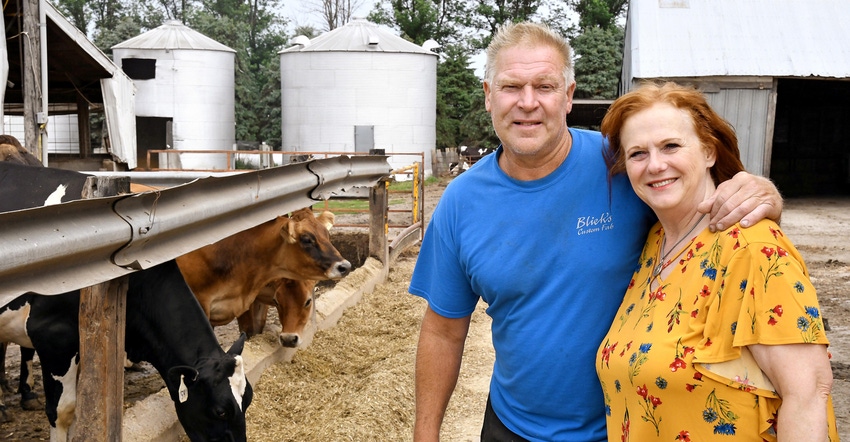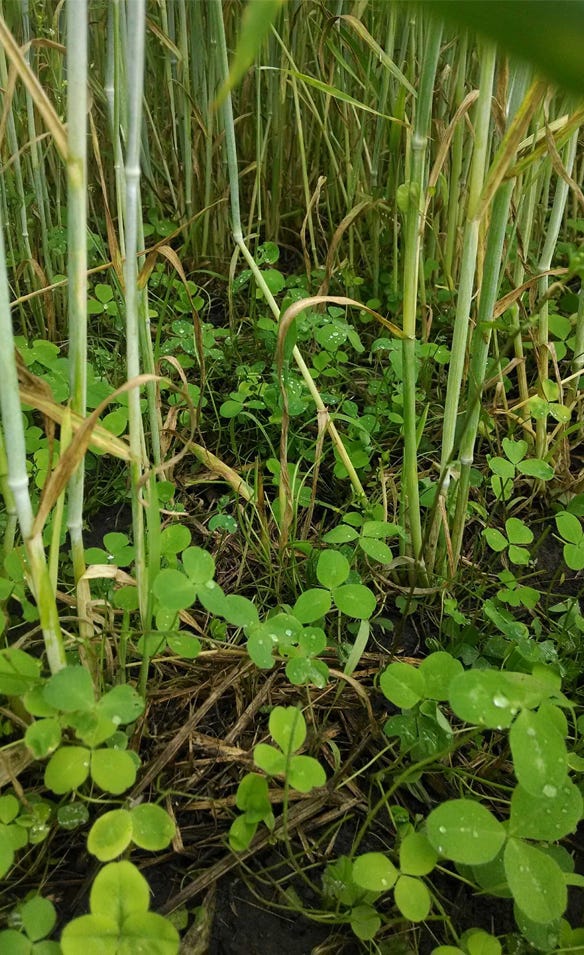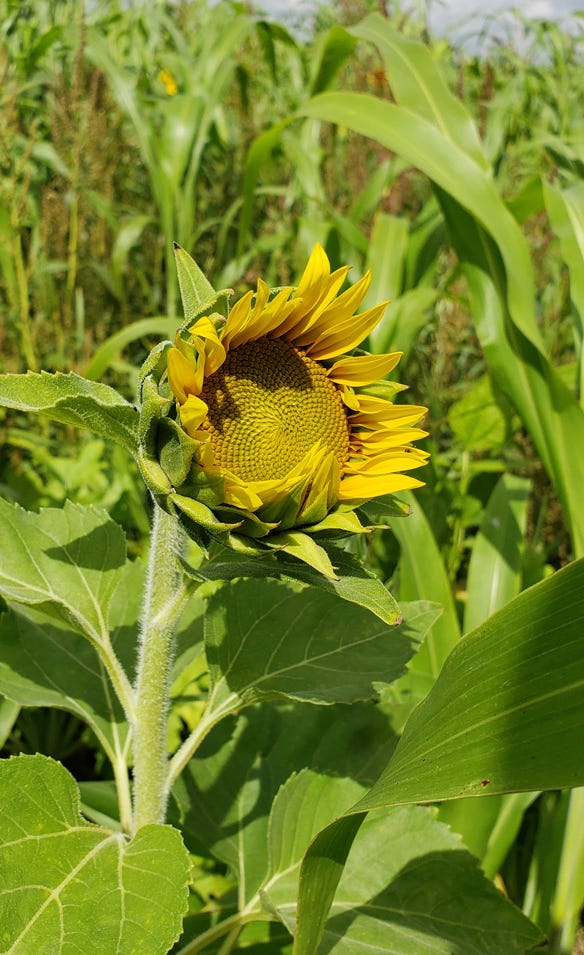March 18, 2019

By Alisha Bower
During the 1980s farm crisis, Practical Farmers of Iowa was founded by farmers who were looking for ways to reduce their inputs, bring down annual operating costs, and make it through the lean times until land and crop prices came back into balance. Back then, they investigated extended rotations that included legumes to grow nitrogen instead of buying fertilizer inputs. That lesson is more applicable than ever in today’s ag economy.
Legumes tend to have more expensive seed and don’t fix much nitrogen until the plant flowers usually impossible in the short and cold time between corn and soybean harvest and planting. But farmers who harvest a small grain in July have a unique opportunity to use legume cover crops that will have time to produce nitrogen.
Farmers looking at growing a legume cover crop have two main options: seed a clover or alfalfa cover crop in early spring so it is growing at the same time as the small grain, or wait until August after small-grain harvest and then plant a cover crop.
How much N from a cover crop?
Daryl DeGroot, farming near Hull in northwest Iowa, decided to test a one-year cover crop of alfalfa co-seeded with oats in 2017. “We drilled 16 pounds per acre of alfalfa with the oats,” he explains. “Usually alfalfa is pretty expensive, but we had the opportunity to buy an older variety from our dealer that was cheaper than red clover seed.”

UNDERSEEDING: An underseeding of clover with rye (pictured) or co-seeding of oats and alfalfa is one option for establishing a cover crop in the small-grain year that allows for maximum nitrogen production. The clover or alfalfa is ready to take off immediately after the small grain is harvested. With an underseeding, it’s best to remove straw to allow light to reach the legume below.

DeGroot farms row crops and has a 250-cow dairy herd, so he’s no stranger to growing alfalfa as a crop. But this was the first year he used it as a cover crop. He let the alfalfa grow for only a single year before terminating it and planting corn the next year.
After harvesting oats in July 2017, DeGroot harvested square bales of straw, his usual practice. “It helps the alfalfa get uncovered so it can grow,” he says. Later that fall, he took a forage cutting of the alfalfa (about 2 tons per acre), and then injected manure into the field.
“The field is next to a hog facility, so we spread a lot of manure there,” he notes. It’s a farrowing facility, so there isn’t a lot of nitrogen in the manure. They have it tested periodically, and it’s about 11 pounds of N per 1,000 gallons out of that lagoon. In fall 2017, they applied 14,000 gallons of the manure to the field and figured it gave them about 140 pounds of N per acre. “We injected the manure into the alfalfa,” he says. “You could see where it went, but the alfalfa didn’t get disturbed too much.”
Planting corn into terminated alfalfa
After hay cutting and manure application, the alfalfa still had a little time to grow in the fall. DeGroot says it grew 4 to 5 inches that fall after manure application and another 4 to 5 inches in the spring. It was just shy of a foot tall when he terminated it with Roundup. “It was an old, cheap alfalfa variety,” he says. “We were able to terminate it completely with a pass of Roundup and Surestart 10 days before we planted corn.”
After the alfalfa was terminated, DeGroot planted into the residue with the same settings he uses to plant into a rye cover crop. “We fill the 400-gallon tank that’s meant for starter fertilizer with water to get down pressure,” he says. “I run one rubber and one spiked closing wheel with trash whippers.”
DeGroot’s nitrogen plan for his corn came entirely from the manure he applied and the nitrogen he estimated from his alfalfa. “Often we’ll do a spring nitrate test, but we didn’t get it done in spring 2018 because the weather was so poor,” he says, “so we’re not exactly sure how much N came from alfalfa. Usually I figure if it’s a two-, three- or four-year alfalfa stand, I’ve got all the N I need for a corn crop. From the one year, I figured I had half of a usual nitrogen program or 80 pounds or so per acre.”
At harvest, he could see if this one-year alfalfa experiment worked. Although he harvested 235 bushels per acre corn, DeGroot cautions, “I have years of history applying manure on this field.” Farmers just starting out in a three-year rotation or who don’t have manure in their farming system should do more testing of both manure and spring soils, so they can make informed decisions about how much N is needed for a corn crop.
N from summer cover mix
Meanwhile, near Boone in central Iowa, Jeremy Gustafson decided he wanted to prioritize diversity in his summer cover crop after oat harvest. “I went with a diversified mix because we don’t have the opportunity to get a lot of diversity in a corn-soybean rotation,” he says. “I also wanted to plant a winterkill cover because I knew I wanted to apply hog manure to that field in the fall, and I could plant corn without worrying about terminating in spring.”
The mix he selected had eight species: mung beans (5 pounds per acre), ironclay cowpeas (10 pounds per acre), German millet (4 pounds per acre), nitro-radish (1.5 pounds per acre), brown mustard (1 pound per acre), flax (2 pounds per acre), buckwheat (6 pounds per acre) and sunflowers (2 pounds per acre).

SUMMER COVER: Jeremy Gustafson has experimented with planting a diverse summer cover after an oat crop to provide pollinator habitat and sequester nitrogen for corn in the following year of the rotation.

Like DeGroot, Gustafson also harvested straw from the oat crop. “By fall that field had blossoms on it and was pollinating, you could tell the cover crop was working to bring diversity of insects, as well as plants to my farm,” he says.
Later that fall when the cover crop was thriving, Gustafson applied hog manure. “We have our own manure tank mounted onto strip-till units,” he says. “We get manure sampled every time we put it on, so we have a good grasp of its nutrient content. It varies from building to building. On this field, we applied manure with a nutrient content N-P-K of 20-20-30 per 1,000 gallons. We’ve found that lowering the gallonage and covering more acres gets better long-term outcomes with manure breaking down gradually over time and releasing more nutrients year to year.”
Gustafson estimates there was 60 pounds of N in the application to this field.
Spring pre-sidedress soil N test
In the spring, Gustafson cultivated the field to work the cover crop residue in, and then planted corn with his normal herbicide program. “Since it was winterkill,” he says, “we didn’t do anything different with the planter.”
He also took a pre-sidedress nitrate test to measure the nitrate available in his soil and took that into consideration along with his historical knowledge of performance on that field. The test showed he had about 30 pounds N per acre available in the soil already, so he topdressed only 70 additional pounds of N with Y drops in June. Together, 30 pounds of N from the cover crop, 60 pounds from hog manure and 70 pounds of N from liquid 32% made up his total nitrogen program of 160 pounds per acre.

COVER GOALS: A summer cover crop mix can meet a variety of different goals. Not only do legumes fix nitrogen, they flower and provide pollinator habitat. This was one of Jeremy Gustafson's goals, as he used sunflowers in the mix in addition to legumes and grasses.

In 2018, Gustafson’s corn grown in this extended-rotation field yielded 210 bushels per acre with 130 pounds of applied nitrogen; only 70 of which came from a purchased fertilizer product. So, he was able to meet his goals of adding diversity to his fields, increase pollinator habitat and save money on fertilizer.
Both Gustafson and DeGroot stress the importance of testing to make confident decisions regarding their nitrogen programs, particularly as they are just starting out trying these cropping systems and don’t have a lot of historical knowledge about how these systems will perform on their farms. Soil and manure tests allow them to make informed decisions to cut their purchased fertilizer inputs while maintaining competitive corn yields for their areas.
Dial-in, listen and learn
This article is based on PFI’s March small grains “shared learning call.” Each month, PFI invites farmers, researchers and industry professionals to share tips and findings on small grains production. Farmers from across Iowa and the Midwest call in to listen and ask questions. For more information about joining these calls, contact Alisha Bower, PFI strategic initiatives manager at [email protected] or 515-232-5661.
Bower is strategic initiatives manager with PFI in Ames, focusing on cover crops and small grains programs.
Source: PFI, which is responsible for the information provided and is wholly owned by the source. Informa Business Media and its subsidiaries aren’t responsible for any of the content contained in this information asset.
You May Also Like




